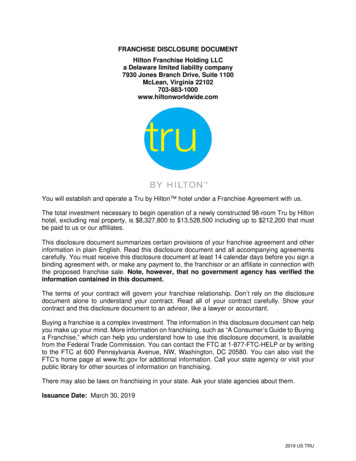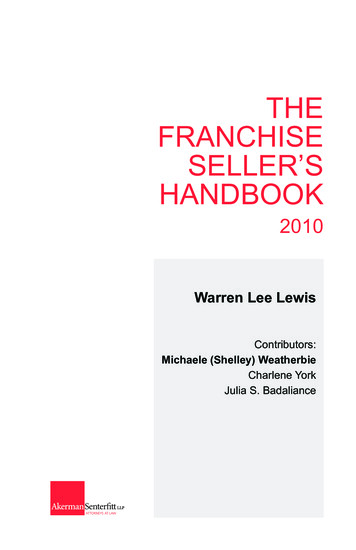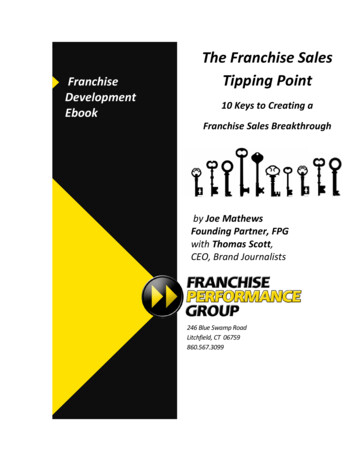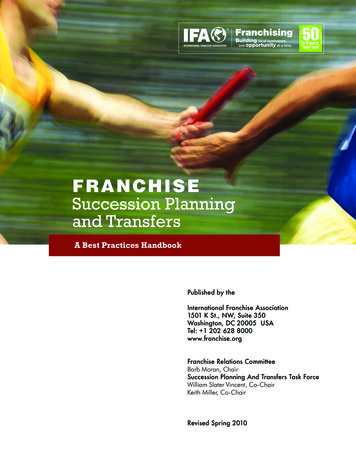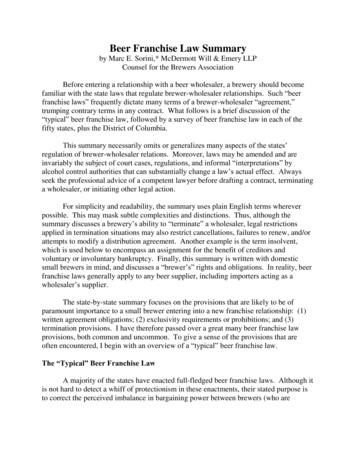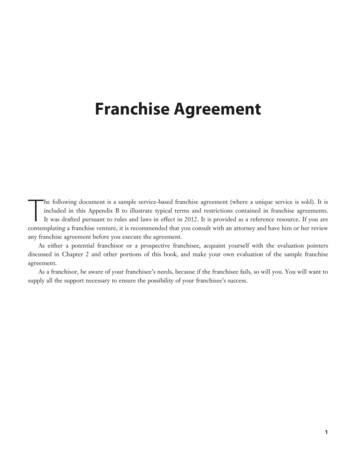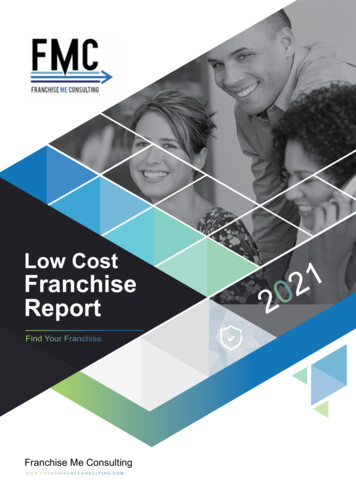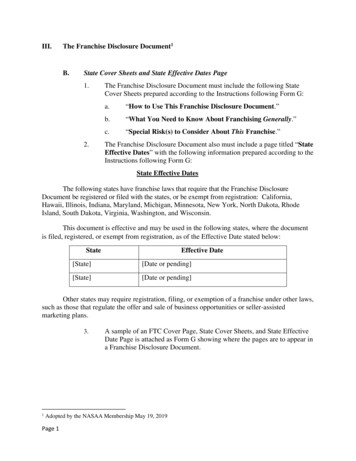
Transcription
III.The Franchise Disclosure Document1B.State Cover Sheets and State Effective Dates Page1.2.The Franchise Disclosure Document must include the following StateCover Sheets prepared according to the Instructions following Form G:a.“How to Use This Franchise Disclosure Document.”b.“What You Need to Know About Franchising Generally.”c.“Special Risk(s) to Consider About This Franchise.”The Franchise Disclosure Document also must include a page titled “StateEffective Dates” with the following information prepared according to theInstructions following Form G:State Effective DatesThe following states have franchise laws that require that the Franchise DisclosureDocument be registered or filed with the states, or be exempt from registration: California,Hawaii, Illinois, Indiana, Maryland, Michigan, Minnesota, New York, North Dakota, RhodeIsland, South Dakota, Virginia, Washington, and Wisconsin.This document is effective and may be used in the following states, where the documentis filed, registered, or exempt from registration, as of the Effective Date stated below:StateEffective Date[State][Date or pending][State][Date or pending]Other states may require registration, filing, or exemption of a franchise under other laws,such as those that regulate the offer and sale of business opportunities or seller-assistedmarketing plans.3.1A sample of an FTC Cover Page, State Cover Sheets, and State EffectiveDate Page is attached as Form G showing where the pages are to appear ina Franchise Disclosure Document.Adopted by the NASAA Membership May 19, 2019Page 1
Form G[Sample]FRANCHISE DISCLOSURE DOCUMENTSUN VISION FRANCHISING, LLC2018 Mercury Avenue, Suite 1600Venus, Texas 77666(214) 777-2222harry.earth@sunvision.comwww.sun.comAs a SUN VISION franchisee, you will sell solar power-related equipment, training and supplies primarilyto small and medium-sized businesses.The initial investment necessary to begin operation of a SUN VISION franchised business ranges from 145,000 to 350,000. This includes 35,000 to 100,000 that must be paid to the franchisor or its affiliates.This disclosure document summarizes certain provisions of your franchise agreement and other informationin plain English. Read this disclosure document and all accompanying agreements carefully. You mustreceive this disclosure document at least 14 calendar days before you sign a binding agreement with, ormake any payment to, franchisor or an affiliate in connection with the proposed franchise sale. Note,however, that no government agency has verified the information contained in this document.You may wish to receive your disclosure document in another format that is more convenient to you. Todiscuss the availability of disclosures in different formats, contact Harry Earth at 2018 Mercury Avenue,Suite 1600, Venus, Texas 77666, (214) 777-2222, harry.earth@sunvision.com.The terms of your contract will govern your franchise relationship. Don’t rely on the disclosure documentalone to understand your contract. Read all of your contract carefully. Show your contract and thisdisclosure document to an advisor, like a lawyer or an accountant.Buying a franchise is a complex investment. The information in this disclosure document can help youmake up your mind. More information on franchising, such as “A Consumer’s Guide to Buying aFranchise,” which can help you understand how to use this disclosure document, is available from theFederal Trade Commission. You can contact the FTC at 1-877-FTC-HELP or by writing to the FTC at600 Pennsylvania Avenue, NW, Washington, DC 20580. You can also visit the FTC’s home page atwww.ftc.gov for additional information. Call your state agency or visit your public library for other sourcesof information on franchising.There may be laws on franchising in your state. Ask your state agencies about them.Issuance Date: August 1, 2018Page 2
How to Use This Franchise Disclosure DocumentHere are some questions you may be asking about buying a franchise and tips on how tofind more information:QUESTIONHow much can I earn?WHERE TO FIND INFORMATIONItem 19 may give you information about outletsales, costs, profits or losses. You should also tryto obtain this information from others, like currentand former franchisees. You can find their namesand contact information in Item 20 or Exhibit [ ].How much will I need to invest? Items 5 and 6 list fees you will be paying to thefranchisor or at the franchisor’s direction. Item 7lists the initial investment to open. Item 8describes the suppliers you must use.Does the franchisor have thefinancial ability to providesupport to my business?Item 21 or Exhibit [ ] includes financialstatements. Review these statements carefully.Is the franchise system stable,growing, or shrinking?Item 20 summarizes the recent history of thenumber of company-owned and franchised outlets.Will my business be the only[XYZ] business in my area?Item 12 and the “territory” provisions in thefranchise agreement describe whether thefranchisor and other franchisees can compete withyou.Does the franchisor have atroubled legal history?Items 3 and 4 tell you whether the franchisor or itsmanagement have been involved in materiallitigation or bankruptcy proceedings.What’s it like to be [an XYZ]franchisee?Item 20 or Exhibit [ ] lists current and formerfranchisees. You can contact them to ask abouttheir experiences.What else should I know?These questions are only a few things you shouldlook for. Review all 23 Items and all Exhibits inthis disclosure document to better understand thisfranchise opportunity. See the table of contents.Page 3
What You Need To Know About Franchising GenerallyContinuing responsibility to pay fees. You may have to pay royalties and other feeseven if you are losing money.Business model can change. The franchise agreement may allow the franchisor tochange its manuals and business model without your consent. These changes may requireyou to make additional investments in your franchise business or may harm yourfranchise business.Supplier restrictions. You may have to buy or lease items from the franchisor or alimited group of suppliers the franchisor designates. These items may be more expensivethan similar items you could buy on your own.Operating restrictions. The franchise agreement may prohibit you from operating asimilar business during the term of the franchise. There are usually other restrictions.Some examples may include controlling your location, your access to customers, whatyou sell, how you market, and your hours of operation.Competition from franchisor. Even if the franchise agreement grants you a territory, thefranchisor may have the right to compete with you in your territory.Renewal. Your franchise agreement may not permit you to renew. Even if it does, youmay have to sign a new agreement with different terms and conditions in order tocontinue to operate your franchise business.When your franchise ends. The franchise agreement may prohibit you from operating asimilar business after your franchise ends even if you still have obligations to yourlandlord or other creditors.Some States Require RegistrationYour state may have a franchise law, or other law, that requires franchisors toregister before offering or selling franchises in the state. Registration does not mean thatthe state recommends the franchise or has verified the information in this document. Tofind out if your state has a registration requirement, or to contact your state, use theagency information in Exhibit [ ].Your state also may have laws that require special disclosures or amendments bemade to your franchise agreement. If so, you should check the State Specific Addenda.See the Table of Contents for the location of the State Specific Addenda.Page 4
Special Risks to Consider About This FranchiseCertain states require that the following risk(s) be highlighted:1.Out-of-State Dispute Resolution. The franchise agreement requires you toresolve disputes with the franchisor by mediation, arbitration and/or litigationonly in [State]. Out-of-state mediation, arbitration, or litigation may force youto accept a less favorable settlement for disputes. It may also cost more tomediate, arbitrate, or litigate with the franchisor in [State] than in your ownstate.Certain states may require other risks to be highlighted. Check the “State SpecificAddenda” (if any) to see whether your state requires other risks to be highlighted.Page 5
Body of Franchise Disclosure DocumentItems 1-22Page 6
State Effective DatesThe following states have franchise laws that require that the Franchise DisclosureDocument be registered or filed with the state, or be exempt from registration:California, Hawaii, Illinois, Indiana, Maryland, Michigan, Minnesota, New York, NorthDakota, Rhode Island, South Dakota, Virginia, Washington, and Wisconsin.This document is effective and may be used in the following states, where thedocument is filed, registered or exempt from registration, as of the Effective Date rylandMichiganMinnesotaNew YorkNorth DakotaRhode IslandSouth DakotaVirginiaWashingtonWisconsinEffective DatePendingMay 17, 2020PendingMay 20, 2020PendingMay 10, 2020May 23, 2020June 15, 2020May 10, 2020May 11, 2020May 10, 2020May 31, 2020PendingMay 9, 2020Other states may require registration, filing, or exemption of a franchise underother laws, such as those that regulate the offer and sale of business opportunities orseller-assisted marketing plans.Page 7
Instructions for PreparingState Cover Sheets and State Effective Date Page1.Insert the State Cover sheets immediately following the FTC required Cover Pagedescribed in Part VII.2.Include the page titled “How to Use This Franchise Disclosure Document” asillustrated in the Sample in Form G.3.4.Page 8a.Format the information on a single page, in at least 13 point type.b.Use bold text only as illustrated in the Sample.c.Do not add, modify, or delete any of the information in the Sample page,except as described below.d.Insert the name of the franchise business where indicated in the firstcolumn, and the appropriate Exhibit letters or numbers from thefranchisor’s Franchise Disclosure Document where indicated in the secondcolumn.On the page immediately following “How to Use this Franchise DisclosureDocument,” include the page titled “What You Need to Know AboutFranchising Generally” as illustrated in the Sample in Form G.a.Format the information on a single page, in at least 13 point type.b.Use bold and underlined text only as illustrated in the Sample.c.Do not add, modify, or delete any of the information in the Sample, exceptas described below.d.Insert the appropriate Exhibit letter or number from the franchisor’sFranchise Disclosure Document where indicated in the second to lastparagraph.On the page immediately following “What You Need to Know About FranchisingGenerally” include the page titled “Special Risk(s) to Consider About ThisFranchise” as illustrated in the Sample in Form G.a.Unless otherwise directed to do so by a state, include this information on asingle page, in at least 13 point type.b.If a franchisor requires any dispute resolution outside of a franchisee’shome state, include the risk factor captioned Out-of-State DisputeResolution, conforming the disclosure to the franchisor’s requirements andinserting the applicable state or jurisdiction.c.Include additional risk factors if required by a state.d.Do not add, modify, or delete any risk factor unless specifically directed todo so by a state.
5.Page 9e.Number all risk factors if more than one risk factor is required.f.Disclose any other risk factor or factors required by a State on the samepage, unless the state allows the risk factor or factors to appear on aseparate State Addendum under a heading captioned “Special Risk(s) toConsider About This Franchise.”g.A risk factor may be allowed to appear on a State Addendum if it is statespecific, if it required by only a single state, or if different states insist ondifferent wording for substantially the same risk factor.h.A state required risk factor may include a short caption with the subject ofthe risk. If so, follow the format illustrated in the Sample, using bold andunderlining for the caption only.i.Do not use ALL CAPS, multiple fonts, bold face, or underlining of thetext of a risk factor, unless specifically directed to do so by a state.j.If any risk factors appear in a State Addendum, include the followingstatement at the end of the page titled Special Risk(s) to Consider AboutThis Franchise: Certain states may require other risks to be highlighted. Ifso, check the “State Specific Addenda” pages for your state.Insert a page titled State Effective Dates immediately before theacknowledgement of receipt pages required under Item 23 of Part VII.a.Use the format illustrated in the Sample in Form G.b.If a franchisor is filing for registration in only one state, the franchisormay insert the state effective date information on the same page as theSpecial Risks to Consider About This Franchise page, if the informationwill fit on a single page with text not less than 13 point type.c.List an effective date or pending only for those states where a franchiseregistration, filing, or exemption application has been made or is pending.d.Regional franchisors may add a statement to the State Effective Date pagethat their territory is limited to a specific state or states.e.As registrations are ordered and made effective, the State Effective Datepage can be modified by the franchisor without any refiling or amendmentapplications with the states.
III. The Franchise Disclosure Document1 B. State Cover Sheets and State Effective Dates Page 1. The Franchise Disclosure Document must include the following State Cover Sheets prepared according to the Instructions following Form G: a. "How to Use This Franchise Disclosure Document." b. "What You Need to Know About Franchising Generally."


